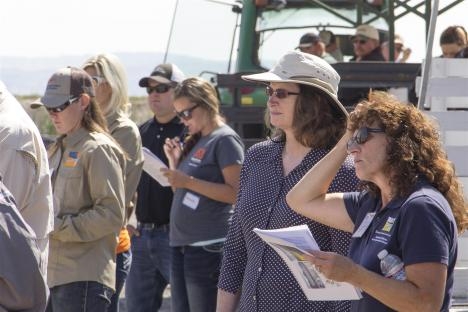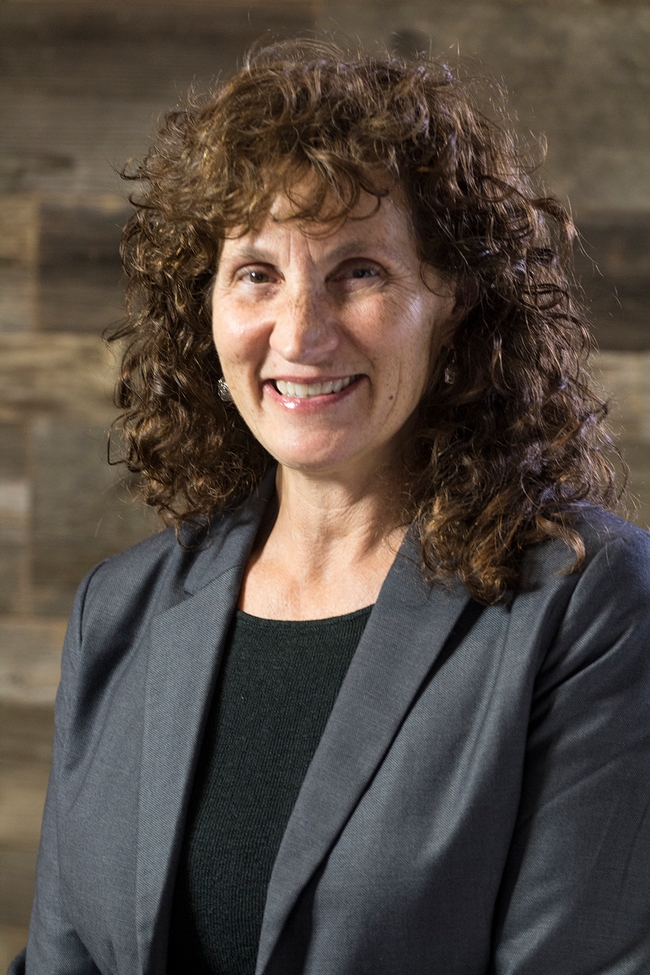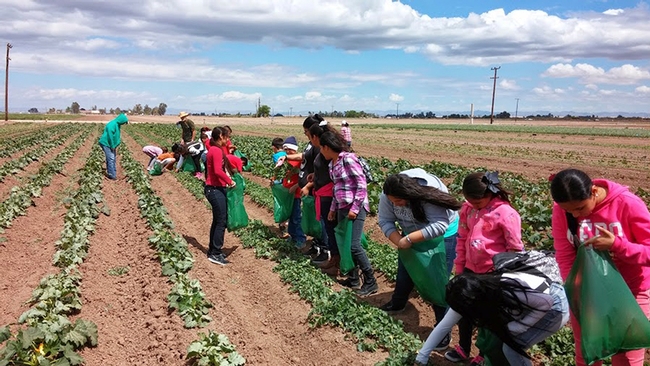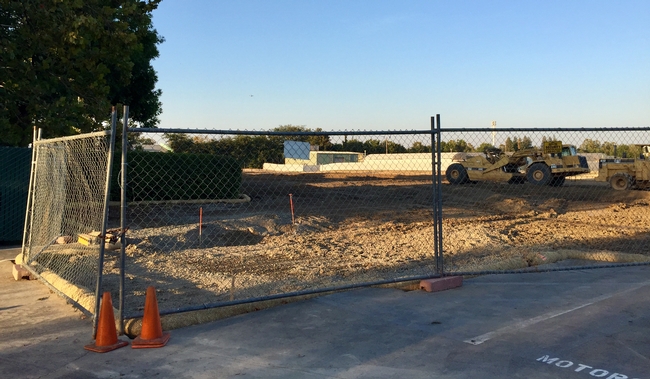Posts Tagged: September 2017
NIFA to hold listening session in Sacramento Nov. 2
What should be a priority in food and agriculture research, extension or education? The National Institute of Food and Agriculture (NIFA) at the U. S. Department of Agriculture (USDA) is seeking stakeholder input on the emerging needs and opportunities in the food and agricultural sciences.
NIFA is holding four listening sessions across the nation. On Nov. 2, “NIFA Listens: Investing in Science to Transform Lives” will be in Sacramento, starting at 8:30 a.m. To attend, you must register by Oct. 12 at https://nifa.usda.gov/nifalistens. If you would like to give a five-minute presentation, submit a 250-word abstract describing your topic.
UC ANR members and stakeholders are strongly encouraged to participate in one of these listening sessions to alert NIFA to the emerging needs and opportunities in California's food and agriculture system. Feedback gathered throughout the initiative will be evaluated, along with input from NIFA employees, in the context of NIFA's current science emphasis areas, to identify gaps in current portfolios and potential investment opportunities.
The other three regional in-person listening sessions are
Oct. 19, Kansas City, Missouri
Oct. 26, Atlanta, Georgia
Nov. 8, Hyattsville, Maryland
NIFA will accept written comments through Friday, Dec. 1, 2017, at https://www.surveymonkey.com/r/Q6HDGC3 and NIFAlistens@nifa.usda.gov.
REC System director Lisa Fischer reflects on strengths and potential of the research and extension centers as she retires
After a nearly 30-year career that took her from the U.S. Forest Service to director of UC ANR's Research and Extension Center system, Lisa Fischer is retiring. Her last day is Sept. 30. Darren Haver will serve as interim associate director through the end of the fiscal year.
Fischer joined ANR five years ago as the associate director of the Research and Extension Center system, after more than two decades with the U.S. Forest Service. She was later promoted to director of the RECs.
UC's ANR's nine Research and Extension Centers (RECs) connect UC research and education activities to regional challenges and issues. The nine centers extend from the Oregon border south to Imperial County. Each center has a unique focus. They provide land, labor, facilities and equipment that serve as an outdoor laboratory for researchers focusing on agriculture and natural resources. The RECs also serve as focal points for community participation and education, serving as hubs for UC ANR programs such as Master Gardeners, Master Food Preservers and 4-H. UC ANR RECs also partner with non-UC researchers, including scientists from U.S. Department of Agriculture and California State University. This is publicly funded research at its best.
We recently sat down to talk about her career.
What did you do prior to joining UC ANR? How did that work equip you for your career here?
Prior to joining ANR, I spent 21 years with the U.S. Forest Service. I managed and oversaw statewide and regional programs focusing primarily on forest health for California, Hawai'i and the Pacific Islands. Other statewide programs I was responsible for included conservation, education and forest stewardship. In many ways, the work was similar to the kind of work we do at ANR: working with state and private interests and other cooperators to deliver a full suite of programs to clientele.
I had a very long relationship with UCCE before joining the organization. My relationship with ANR dates back to the mid-1990s, when I was involved in a collaborative project with the Integrated Hardwood Range Management Program.
You received your degrees in Geography from UC Santa Barbara. How has that discipline helped you in your ANR career?
Fischer: Geography is about observing patterns in nature. When I think about that and my journey for the last five years, that disciplinary training seems incredibly applicable. Literally my first goal as Associate Director was to observe: to visit each REC, see what was happening, what each did and what each had to offer. It related not only in terms of learning the unique aspects of each REC, but how each fit into what I can only term a massive, grand and complex system.
For the first nine months, I was simply taking in a great deal of information. The time observing the RECs and speaking with a wide range of people (both within and outside of ANR) enabled me to identify some areas that we really wanted to try expand upon.
A key goal coming in was to increase the visibility of the REC system…to create more of a REC brand. There was another piece to that, which was considering how we might begin to engage in different activities, and considering what that would require.
The process of getting out and exploring possibilities with the REC directors was immensely fun, engaging and productive. We visited campus departments and spoke with graduate students, including those enrolled in geography, ecology and plant sciences.
UC ANR has done a wonderful job of providing hands-on experiences for K-12 and for UC and CSU students. It was also important for me to provide experiences for community college students. One of things I did early on with Bill Frost's blessing was to create an intern program. Initially, we were looking at how students might help us help to gain visibility, but we realized that these experiences might lead to future employment opportunities for these young people. So, I wove that into the pattern I saw.
I have always tried to be creative and consider how we can grow our REC system both internally as well as externally.
The RECs are being used in some new and exciting ways. Could you elaborate on that?
I'm very passionate about the Extension part of our work. Internally, I began having conversations in hallways about bringing groups together that could actually be present at the RECs. A central question was “How can we use these inter-connected physical places and locations across the state to benefit and host the full suite of ANR programs?”
One of the first centers to do this was South Coast REC in Irvine, where Director Darren Haver brought Cooperative Extension county programs and REC programs under one umbrella. Slowly, we also did that this at Hansen Agricultural Research and Extension ECenter (HAREC) in Ventura County. And for the first time ever, every acre at HAREC is being used for research and educational activities. More academics are engaging with RECs. We've improved.
Another creative and interesting opportunity has arisen from taking amazing research and programmatic work, and packaging it and delivering it in various ways to different audiences, from K-12 to the general public to international groups. Having RECs focusing on outreach, integrating programs and bringing different ideas for new outreach efforts has been very successful on a number of fronts. For example, Project Learning Tree uses RECs as places to convene different clientele and stakeholders. They conduct not only forestry-related teacher training, but also training to equip those educating others about natural resources, agriculture, wastewater and more.
We've really expanded the community educator capacity in the REC system. A model for the great potential of this work has been the Farm Smart program at Desert REC (DREC) in Imperial County. Farm Smart provides an on-site educational program serving grades K-12 and winter visitors (“snowbirds”). To date, it's served over 120,000 people. It's a very successful outreach and extension program that integrates a REC-based program with a county-based program. We've used Farm Smart as a model to launch other programs and educator positions across the system, including Sustainable You, a youth-development program that's involved 4-H, Master Gardener volunteers, the California Naturalist Program, Project Learning Tree and other county-based community educators. Sustainable You – a program developed by Utah State University – has launched at several RECs.
Which accomplishments are you most proud of?
I think that the strategic planning effort we undertook was absolutely amazing. When I came to ANR five years ago, one of the tasks given to me was to lead the creation of fully stakeholder-driven strategic plans. The process we developed to create these plans was amazing. Each of the nine centers convened committees consisting of stakeholders, specialists and advisors within thematic areas that were unique and critical to each REC.
It was a creative and open process that allowed for a continual flow of information from many and diverse parties.
It has been inspiring to develop and look out at a long-term plan (each plan projects out 20 years). What will the center look like? What will the work look like? What will the research facilities look like? How will we get there? The unique part of these plans is that they key in on a broad, strategic lens that reflects public values, such as enhanced science literacy. Goals are considered through these lenses, which has resulted in very strategic and creative action plans. These plans include anticipated outcomes and expected deliverables, but provide flexibility to adapt as the need arises. These are living plans that REC directors and their successors can reference, utilize, refine and use to guide annual work.
The strategic planning process also broadened our thinking and created an entire new set of questions about who we might work with at each REC, and the diversity of research efforts that might be undertaken in the future. Could we work with engineers? Artists? Writers? How do we expand partnerships in ways that not only help us maintain fiscal health and stability, but in ways which will enhance the diversity of research and education activities? Because of the sprawling nature of the REC system and the physical space that divides us, we've even discussed distance learning.
After five years, what's your takeaway about the REC system you've managed?
My perspective on the REC system is that it represents a simply amazing breadth of ecosystems and much of the amazing geographic and physical diversity that characterizes California. It's a unique place-based system that incorporates research, education, outreach and extension.
I feel as if I've just touched on the surface of what's possible here.
What would you want to tell advisors and others beginning their career with UC ANR?
Until I got involved in this position, I had no true understanding of how extraordinarily valuable a resource the RECs are for researchers and California taxpayers. These diverse physical locations exist as creative spaces for research and programmatic development and delivery. Opportunities abound. The potential is unlimited.
I'd also tell people to keep their eyes open and to consider the other kinds of research and programmatic opportunities that might arise. Step outside of the box a bit. It's essential to keep the research and extension mission in focus. But knowing that is our focus, it's important to note that research is very expansive: there are social, physical, biological, chemical, mechanical, and cultural aspects of critical issues that can be explored. Research can be conducted in any number of disciplines at the RECs. So, continue to seek out those different opportunities…that will assure that ANR remains in the forefront of creative research and Extension work.
I feel very strongly about that.
Storm-water runoff study planned for ANR’s backyard
Construction of a new parking lot for the ANR building in Davis is providing an opportunity for UC ANR to demonstrate science at the site by integrating an ongoing water-quality research project.
The research project on the recently purchased 10 acres at 3031 Second St. was developed by Missy Gable, director of the Master Gardener Program; Loren Oki, UC Cooperative Extension specialist in environmental horticulture at UC Davis; Igor Lacan, UC Cooperative Extension urban forestry advisor for San Mateo County; and Marq Truscott, a retired landscape architect who lectures for the Landscape Architecture Program at UC Davis.
The researchers will evaluate the effect of parking surfaces paved with different materials and coupled to rain garden swales on storm water runoff quality and quantity, according to Jan Corlett, chief of staff to the vice president, who is overseeing the project.
The study area of the parking lot will have the swales and three different surface types – typical asphalt, a cellular confinement system and permeable pavers. The researchers will study how these features improve water quality by removing pollutants and reduce runoff volumes by improving soil infiltration. They will be able to collect samples of runoff water from the different paved surfaces.
In addition, all trees planted in the parking lot will have engineered substrates to demonstrate their long-term effect on tree health and condition.
The new lot will add 92 full-sized, paved parking spaces and 40 parking spaces on gravel to the existing 96 spaces at 2801 Second St.
In 2016, a team that did planning for the 3031 Second St. site envisioned a collaborative, systemwide showcase, supported by the following key goals:
- Enhance the visibility of ANR's mission, research and educational programs that affect the lives of all Californians
- Ensure an inclusive approach to design and programming that welcomes all members of the ANR community, as well as outside researchers and stakeholders
- Support the core mission of ANR by ensuring the campus has a full suite of properly-sized and flexibly programmed facilities and spaces
- Capitalize on the opportunity to tell ANR's story both to the University of California community and outside stakeholders
- Promote community health and wellness in every aspect of site design and facility programming
- Reflect the natural California landscape through appropriate site design and landscaping
“This project reflects many of those goals by demonstrating that everything ANR does, even building a parking lot, can include research and extension opportunities,” Corlett said. “The City of Davis is very supportive of this effort, and we expect that it will draw many visitors each year.”
The project broke ground Sept. 5 and is expected to be completed in November.
UCCE in Merced establishes an endowment to fund future ag programming
The growing popularity of crowd funding got UC Cooperative Extension advisor David Doll thinking.
“By everybody giving a little, you can get a lot,” he said. “We can do the same thing.”
Doll mulled over the idea for a few years, talked with his colleagues at UCCE in Merced County, and launched a unique funding plan for the future of agricultural research.
“Over the years, there has been a consistent erosion of base funding for our services, not only from UC, but also the county and federal governments,” he said. “We want to build a strong foundation for ag programming, like we had in the past. Something that would last longer than anyone's tenure in the office.”
Doll and UCCE county director in Merced County Scott Stoddard worked with the UC ANR Development office to solicit donations needed for the establishment of an endowment to support ag research in Merced County.
Initial fundraising over the last six months has brought in about $15,000 for the pioneering endeavor, enough to form an official, if small, endowment. The endowment can spin off interest and provide support for perpetuity.
“Eventually, we would like to see the endowment reach the $300,000 to $400,000 range, so it will bring a few thousand dollars each year and build in time with continual support from the community,” Doll said.
To make a contribution, go to the UCCE Merced County giving page, https://donate.ucanr.edu/pages/uccemerced. For designation, select the “Agriculture Extension and Research Endowment” in the dropdown menu.
ANR develops cost-recovery strategy to improve REC facilities
UC ANR leadership is proud of its outstanding network of nine Research and Extension Centers across the state. Including academic salaries and temporary funding, UC ANR invests close to $14 million annually in the REC system. We are committed to continuing to make an investment of this magnitude, recognizing the importance of each individual REC, and the REC system to our research and extension missions.
A freeze on state operations and maintenance funding since 2006, and a virtual absence of deferred maintenance funds, necessitates a close look at how the annual investment is used so as to position the RECs for a long, successful future. UC ANR leadership is taking the long view to its programmatic collaboration and growth. As a result, we are developing a strategy for cost recovery to continue to operate and improve the facilities so that we can better serve researchers and their research and extension activities – well into the next decade, not just the next three to five years.
Key attributes of the strategy include:
- Improved clarity of how full-cost research rates are calculated and how researcher costs are derived, based on a researcher's specific and agreed upon needs for labor and facilities
- Establishment of rates four to six months in advance of the effective date for the rate (i.e. rates published in January for projects beginning in July, or some variation thereof) in recognition of the need to project costs in advance of research start date
- Development of a cost structure that reflects different project needs and differences in costs required to support the needs
- Ability to confirm researcher costs for specific, itemized research needs over a multi-year timeframe at time of proposal submission to a funding agency
A move to this new way of calculating research rates will take some time to establish across all nine RECs. Our goal is to have this rolled out between January and March 2018 and to go into effect for any projects (new, renewed or expanded usage) beginning July 1, 2018. This is an ambitious goal given the review and approval process in place that ensures fairness of proposed methodology and charges. However, we are committed to making this a high priority in order to improve the research experience.
To assess feasibility of the approach, the Desert REC will move to a new model in the very near term and serve as a pilot study for the July 1, 2017 – June 30, 2018 timeframe. The new model includes different rates for different services (land, water, pesticides, labor, etc.). The new model applies at Desert REC for both new and continuing projects and provides the opportunity to identify any issues early on and make the necessary adjustments. The remaining RECs will develop research rates for REC services over the next few months and the new model will be refined and adapted in 2018-2019 for the remaining eight RECs.
For 2017-2018, researchers continuing projects at all RECs, except Desert REC and West Side REC, should plan on an additional 10 percent to their 2016-2017 research rate to cover increases in salaries and benefit rates and reflect a reduced subsidy by center funds applied to the full cost rate. New and renewed projects will be billed at a researcher rate of $27.46 per hour. A new project is one that has not been submitted to, and approved by, the REC previously. This higher rate reflects the need to reduce the subsidy applied to the full cost rate.
Researchers at West Side REC will be billed at a rate 10 percent above the 2016-2017 West Side REC research rate for all projects.
Developing a new strategy for setting research rates based on different rates for different services will take time, thus the decision to move forward as outlined above. The pilot assessment at Desert REC will illustrate the impacts of a new strategy on both researchers and business operations and help identify best practices to support the transition to a new strategy. We are committed to maintaining a system of RECs that are positioned to address present and emerging research needs for the long term and meet the planning needs of researchers.
|
Research and Extension Center |
New projects and projects renewed at the end of the 3-year cycle |
Continuing projects (2nd and 3rd year) |
|
Desert REC |
Charges based on services utilized (acreage, water, labor etc.) |
|
|
West Side |
2016-17 rate + 10% |
2016-17 rate + 10% |
|
Hansen, Hopland, Intermountain, Kearney, Lindcove, Sierra Foothill, South Coast |
$27.46 |
2016-17 rate + 10% |
Wendy Powers
Associate Vice President for Agriculture and Natural Resources





